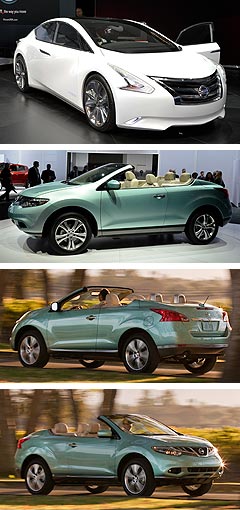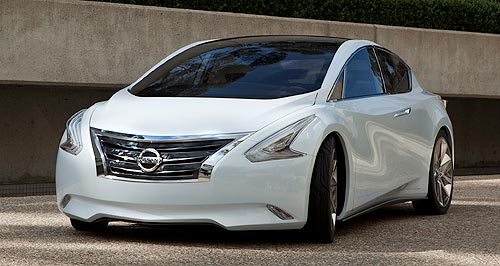Make / Model Search
Future models - Nissan - EllureLA show: Nissan reveals Ellure concept, CrossCabrioletFemale focus: Nissan has targeted women in their 30s and 40s who have a ‘sense of sophistication and rebellion’ with the Ellure mid-sized sedan concept. Nissan rethinks sedan design with Ellure concept as Murano cabrio takes the stage19 Nov 2010 By TERRY MARTIN NISSAN flexed its design muscles at the Los Angeles auto show this week, unveiling the Murano CrossCabriolet SUV-cum-convertible previewed a week earlier and a new styling direction for future medium-sized sedans with the engaging Ellure concept. Both world debuts are designed to show that the Japanese manufacturer is responsive to modern trends and changing consumer preferences, demonstrating a preparedness to re-imagine the conventional notion of SUVs – with the chop-top Murano – and to modernise and even ‘feminise’ the sedan, which is what the Ellure is all about. “While not intended as a preview of any upcoming production model, Ellure confirms Nissan’s intention to be a strong player in the sedan segment for many years to come,” said Nissan senior vice-president and chief creative officer, Shiro Nakamura.  Left: Nissan Ellure. Below: Nissan Murano CrossCabriolet. Left: Nissan Ellure. Below: Nissan Murano CrossCabriolet.“When all is said and done, the sedan will always be core to the Nissan product portfolio. Our goal is to rejuvenate the sedan’s attractiveness to buyers who might have migrated to other segments, or who are coming reluctantly into the category. “As an expression of our long-term vision for the next generation of great Nissan sedans, Ellure allows us to introduce a new sedan concept – one that honours the sedan’s unmatched daytime functionality, yet has a more emotive, almost hidden ambience that comes to life after dark. “It’s an ideal fit for the needs of its projected owners – women in their 30s and 40s with a sense of sophistication and rebellion.” Showing the design direction Nissan is taking for its next-generation front-wheel-drive medium-large cars, including Maxima, the Ellure has an appealing sporting flavour with its solid wheel-at-each-corner stance, broad shoulders, strong crease lines across its flanks and the curving, coupe-like roofline, although Nissan is at pains to emphasise that the vehicle is “not designed to hide its ‘sedan-ness’ as some so-called four-door coupes do, but to honour the form”. Inside, the wrap-around cabin features a long dashboard design that extends into the door panels, while a lounge-like three-position rear seat is used in the rear compartment. Attention to detail in terms of ergonomics is also apparent, with a devotion to clean and intuitive switchgear, large display panels, anti-glare leather on the dash and a truncated steering wheel shape to provide a clearer view of the instruments. Nissan describes the showpiece of the interior as the ‘floating’ centre console with a sculptural, see-through effect, white leather covering and backlit red lighting at night. The other highlight is an all-glass ceiling embedded with special red mood lighting. Under the bonnet, the Ellure has a “proposed” petrol-electric hybrid drivetrain which combines a supercharged 2.5-litre four-cylinder petrol engine with Intelligent Dual Clutch Control (one motor/twin clutch design with lithium-ion battery) and 25kW electric motor. It drives the front wheels through a continuously variable transmission. Nissan admits this is simply a conceptual drivetrain, with other imagined technology on the vehicle including regenerative braking and drive-by-wire steering (either electric or hydraulic). To further highlight the environmental flavour while not, Nissan admits, projecting an obvious ‘eco image’, the designers have also paid particular attention to aerodynamics across the Ellure, such as a full underbody pan, moulded side rearview camera housings (as seen on Subaru’s Impreza concept also shown at LA), small wheel openings, full transparent covers over the five-spoke 21-inch alloy wheels, and low-rolling-resistance Michelin tyres. “Aerodynamics has become a critical element of design for all vehicles today, not just hybrids or EVs,” Mr Nakamura said. “We’ve used Ellure to explore subtle ways to reduce or eliminate body openings that can cause drag, such as the solid yet transparent coverings on the wheels and grilles, without impacting the beauty of the vehicle.” To go on sale in the US early in 2011 – and still to be confirmed for other markets, including Australia – the two-door, four-seater AWD Murano CrossCabriolet is equally striking for Nissan’s sheer audacity in taking a gas axe to the SUV’s roof and pillars, but as we described at its preview, the vehicle looks to be well resolved. “Everyone loves the convertible experience (but) no one loves the convertible reality – compromised trunk space, a cramped back seat or none at all, and a lack of flexibility for everyday life,” said Nissan North America general manager Al Castignetti. “The Murano CrossCabriolet is the reinvention of versatility, encouraging people to rethink what a convertible can be.” Just a single-specification model will be built, loaded with standard equipment and powered by a 3.5-litre V6 petrol engine mated to an Xtronic CVT (with adaptive shift control). The conversion has reduced the door count to two, increased front door length by 200mm, created the need for dual pop-up rollbars at the rear and, with the removal of the load-bearing B-pillars, has required structural reinforcements from the A-pillar rearward. The drag coefficient increases slightly from 0.37 to 0.39Cd. The CrossCabrio uses a fabric roof which incorporates a rear ‘skylight’, which Nissan says aims to create a wide-open interior environment even with the top in the closed position. The hydraulically operated roof mechanism includes an automatic power latch/unlatch system, and, according to the company, packs down to an exceptionally small size when stowed – similar to that of a conventional two-seat roadster. Luggage capacity with the top down is 215 litres, which Nissan says is enough to fit two sets of golf clubs or two carry-on suitcases. With the top closed, cargo capacity expands to 348 litres. Apart from the appealing look with the top down, there are other neat design references on the SUV-cabrio, such as 370Z-inspired LED tail-lights. Nissan also used the LA show to present its new Quest people-mover – another model pitched directly at the US market, and which is not on the agenda for Australia – and the production version of its Leaf EV, which is scheduled to arrive here in 2012.  Read moreAll future models Alfa Romeo Alfa Romeo Abarth Abarth Alpine Alpine Alpina Alpina Audi Audi Aston Martin Aston Martin BMW BMW Bentley Bentley Chery Chery Brabham Brabham Chrysler Chrysler Chevrolet Chevrolet Cupra Cupra Citroen Citroen DS DS Dodge Dodge Fiat Fiat Ferrari Ferrari Foton Foton Ford Ford Great Wall Great Wall FPV FPV Haval Haval GWM GWM Honda Honda Holden Holden Hummer Hummer HSV HSV Infiniti Infiniti Hyundai Hyundai Jaguar Jaguar Isuzu Isuzu Kia Kia Jeep Jeep Land Rover Land Rover Lamborghini Lamborghini Lexus Lexus LDV LDV Mahindra Mahindra Lotus Lotus Mazda Mazda Maserati Maserati Mercedes-AMG Mercedes-AMG McLaren McLaren MG MG Mercedes-Benz Mercedes-Benz Mitsubishi Mitsubishi Mini Mini Opel Opel Nissan Nissan Peugeot Peugeot Pagani Pagani Proton Proton Porsche Porsche Renault Renault Ram Ram Rover Rover Rolls-Royce Rolls-Royce Skoda Skoda Saab Saab SsangYong SsangYong Smart Smart Suzuki Suzuki Subaru Subaru Toyota Toyota Tesla Tesla Volvo VolvoMotor industry news |
Click to shareNissan modelsResearch Nissan All future models Alfa Romeo Alfa Romeo Abarth Abarth Alpine Alpine Alpina Alpina Audi Audi Aston Martin Aston Martin BMW BMW Bentley Bentley Chery Chery Brabham Brabham Chrysler Chrysler Chevrolet Chevrolet Cupra Cupra Citroen Citroen DS DS Dodge Dodge Fiat Fiat Ferrari Ferrari Foton Foton Ford Ford Great Wall Great Wall FPV FPV Haval Haval GWM GWM Honda Honda Holden Holden Hummer Hummer HSV HSV Infiniti Infiniti Hyundai Hyundai Jaguar Jaguar Isuzu Isuzu Kia Kia Jeep Jeep Land Rover Land Rover Lamborghini Lamborghini Lexus Lexus LDV LDV Mahindra Mahindra Lotus Lotus Mazda Mazda Maserati Maserati Mercedes-AMG Mercedes-AMG McLaren McLaren MG MG Mercedes-Benz Mercedes-Benz Mitsubishi Mitsubishi Mini Mini Opel Opel Nissan Nissan Peugeot Peugeot Pagani Pagani Proton Proton Porsche Porsche Renault Renault Ram Ram Rover Rover Rolls-Royce Rolls-Royce Skoda Skoda Saab Saab SsangYong SsangYong Smart Smart Suzuki Suzuki Subaru Subaru Toyota Toyota Tesla Tesla Volvo VolvoMotor industry news |










Facebook Twitter Instagram